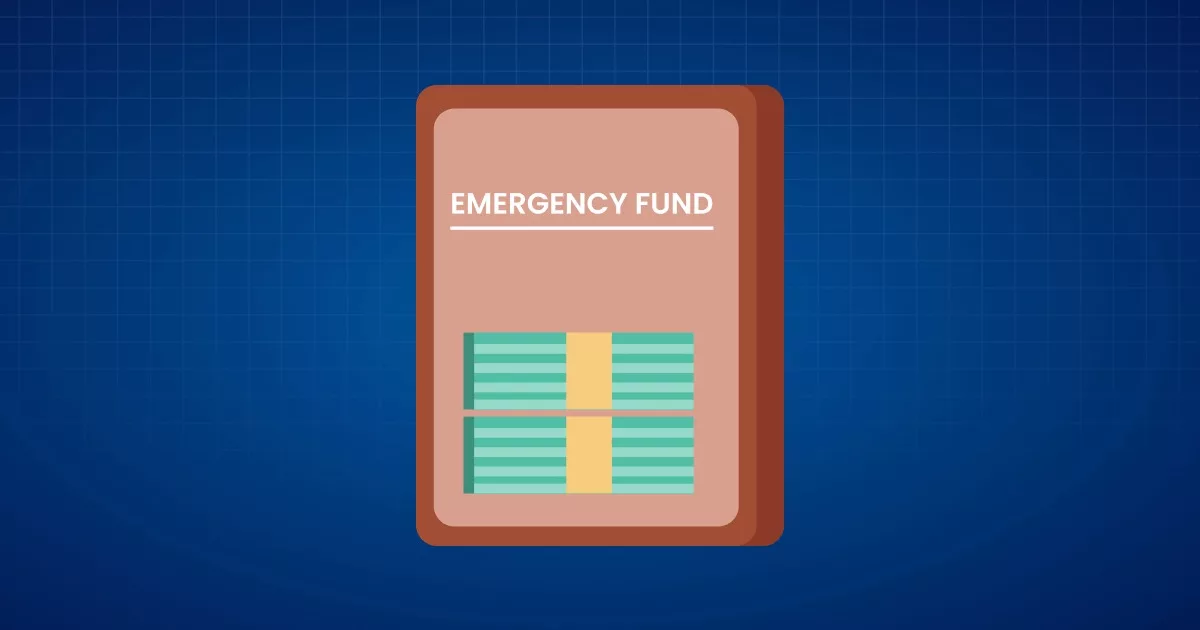
Life is full of unexpected surprises. Unfortunately, not all surprises are positive, especially finance-related. An emergency fund is a safety net that can help weather the storms of unexpected events, such as medical bills or job loss, without disrupting your long-term financial goals. It can give you the time and resources to recover and get back on track. Now, you might be convinced to build your emergency fund. But one question remains unanswered: Where to invest your emergency fund? It is a critical question to answer as we must consider factors like liquidity, safety, returns, etc.
So, let’s dive into this question and the options available, especially in India, to park your emergency fund.
What Is an Emergency Fund?
An emergency fund is savings set aside to cover unexpected expenses or emergencies. It can help during job loss, sudden medical expenses, car repairs, home repairs, and other unexpected bills. It can provide a sense of financial security and help you avoid debt or relying on credit cards to cover these emergencies.
An emergency fund is an essential part of any financial plan. It’s typically recommended to save three to six months of living expenses in an emergency fund.
Suppose your monthly expense is INR 25,000. Your emergency fund can range between INR 75,000 (3x monthly expenses) to INR 150,000 (6x monthly expenses).
Having said that, the actual amount may vary depending on individual circumstances.
Also, you should ensure that your emergency fund is liquid. It should be easily available to you as you may need to access your fund quickly to cover unexpected expenses.
What Are the Effective Strategies for Building an Emergency Fund?
We have understood what exactly an emergency fund is. Now we will look into some effective strategies for building one.
1. Set a goal
Set a goal for your emergency fund. Your fund should cover three to six months of your living expenses. Having a specific savings goal can help you stay focused and motivated.
2. Make it a priority
Make building your emergency fund a priority. Set aside a portion of your income each month towards your emergency fund. Consider it a non-negotiable monthly expense.
3. Automate your savings
Consider automating your savings by setting up a direct deposit from your paycheck to your emergency fund. This can make the task effortless and consistent.
4. Cut expenses
Identify areas where you can cut expenses and redirect that money toward your emergency fund. Consider cutting back on unnecessary expenses like luxury dine-outs or subscriptions you don’t use.
5. Take advantage of windfalls
Use any unexpected windfalls, like tax refunds or bonuses, to add to your emergency fund.
6. Start small
Start small and gradually increase your contributions to your emergency fund. Even small amounts can add up over time and help you build the fund.
7. Avoid using your emergency fund
Avoid using your emergency fund for non-emergency expenses. Use it only for unexpected expenses like a medical emergency or job loss.
Why Should You Invest Your Emergency Fund?
It’s essential to ensure that your emergency fund can be quickly liquidated in case you need to use it and is kept safe.
Traditional savings accounts are a popular choice for emergency funds because they offer both liquidity and safety. But they lag behind regarding returns (2 to 3%).
Thus, instead of relying only on the savings account, you can benefit greatly by investing your funds in low-risk, short-term investment options such as money market accounts or short-term bond funds.
Below are the advantages of investing your emergency fund in these options.
1. Safety and liquidity
Like a regular savings account, low-risk, short-term investments offer safety and liquidity.
2. Higher returns
Investing your emergency fund in these low-risk, short-term investments can provide better returns. While the returns may not be significant, they are still higher than a traditional savings account.
3. Protection against inflation
Over time, inflation can erode your fund’s value if parked in a savings account. On the other hand, investing in low-risk investments can help protect against inflation and ensure your money retains its value.
What to Consider Before Investing Your Emergency Fund?
Investing your emergency fund can be a tricky decision.
Here are some factors to consider before investing your fund.
1. Risk
Before investing, consider the risk associated with the investment. Emergency funds should be parked in low-risk investments as the fund is meant to provide a safety net in case of unexpected expenses. Higher returns generally come with higher risk, so choose a low-risk investment.
2. Liquidity
The primary objective of an emergency fund is to provide quick access to cash when needed. Thus, consider the liquidity of the investment before investing. The investment should be easily accessible and should not have any restrictions on withdrawals.
3. Return
While safety is the top priority for emergency funds, it’s also essential to consider the return on investment. Choose an investment that offers a reasonable return while keeping risk and liquidity in mind. As a rule of thumb, the return on investment should at least come closer to the inflation rate.
4. Investment horizon
Consider the investment horizon of the investment. Short-term investments like money market funds are suitable for emergency funds as they offer quick access to cash.
5. Fees and charges
Check the fees and charges associated with the investment before investing. High fees and expenses can eat into your returns and reduce the effectiveness of the investment.
6. Taxation
Consider the tax implications of the investment options before parking your emergency fund.
Best Low-Risk Investments for Your Emergency Fund in India
The below instruments are designed to provide investors with a low-risk and highly liquid investment option that generates better returns than traditional savings accounts.
1. Money market funds
Money market funds are mutual funds that invest in a diversified portfolio of short-term debt securities with a maturity period of up to 1 year.
1.1.Historical return
The average return on money market funds based on the top-performing funds in the last 3 years is 5% to 7%.
1.2.Minimum investment
Some funds may have a minimum investment amount as low as INR 500, while others may require a minimum investment of INR 5,000 or more.
2. Liquid funds
Liquid funds are mutual funds that invest in highly liquid debt instruments with a maturity period of up to 91 days.
2.1.Historical return
Liquid funds have delivered returns of more than 7% in the past. The returns on liquid funds are typically linked to prevailing short-term interest rates in the market.
2.2.Minimum investment
The minimum investment amount can be as low as INR 500.
3. Ultra short-term funds
Ultra short-term funds are a type of debt mutual fund that invests in a diversified portfolio of debt securities with a maturity period of three to six months.
3.1.Historical return
The ultra short-term funds can offer between 5 to 6%.
3.2.Minimum investment
Some funds may have a minimum investment amount as low as INR 1,000.
4. High-yield savings account
High-yield savings accounts are a type of savings account offered by some banks and financial institutions offering higher interest rates than a regular account.
These accounts are designed to give investors a low-risk and liquid option for storing their cash reserves while earning a better return.
4.1.Interest rate
High-yield savings accounts in India can offer up to 7%. The returns on these accounts are usually linked to prevailing interest rates in the market and may vary from bank to bank.
4.2.Minimum deposit
Some banks may have a minimum investment amount as low as Rs. 1,000, while others may require a minimum investment of Rs. 10,000 or more.
Conclusion
According to a survey conducted by Finology Ventures, most Indians, approximately 75%, do not possess an emergency fund. This puts them at risk in case they face unexpected job loss or loss of income due to unforeseen circumstances.
Remember, emergencies can arise anytime. A well-planned emergency fund can help weather the storm without disrupting your financial stability.
Various low-risk investment options in India can provide high liquidity while ensuring the safety of your investment. Evaluating these options before choosing one for your emergency fund is essential.
So, invest your emergency fund wisely and stay financially prepared for any unexpected situations that may come your way.
FAQs
1. How much should you keep in your emergency fund?
The amount you should keep in your emergency fund depends on your personal circumstances, such as your monthly expenses, job security, and potential financial emergencies.
A standard recommendation is to save at least three to six months of living expenses.
Suppose your monthly expense is INR 25,000. Your emergency fund can range between INR 75,000 (3x monthly expenses) to INR 150,000 (6x monthly expenses).
Having said that, the actual amount may vary depending on individual circumstances.
2. What is the difference between savings and money market accounts?
Savings accounts typically offer lower interest rates than money market accounts but have lower minimum balance requirements.
Money market accounts offer higher interest rates but require higher minimum balances and may limit the number of transactions allowed.
3. Can you lose money in a low-risk investment?
Low-risk investments, such as bonds or savings accounts, typically have a lower potential for loss than high-risk investments.
But, there is still a possibility of losing money due to inflation or other factors, such as changes in interest rates or default risk. It’s vital to consider your investment goals and risk tolerance before making investment decisions.





